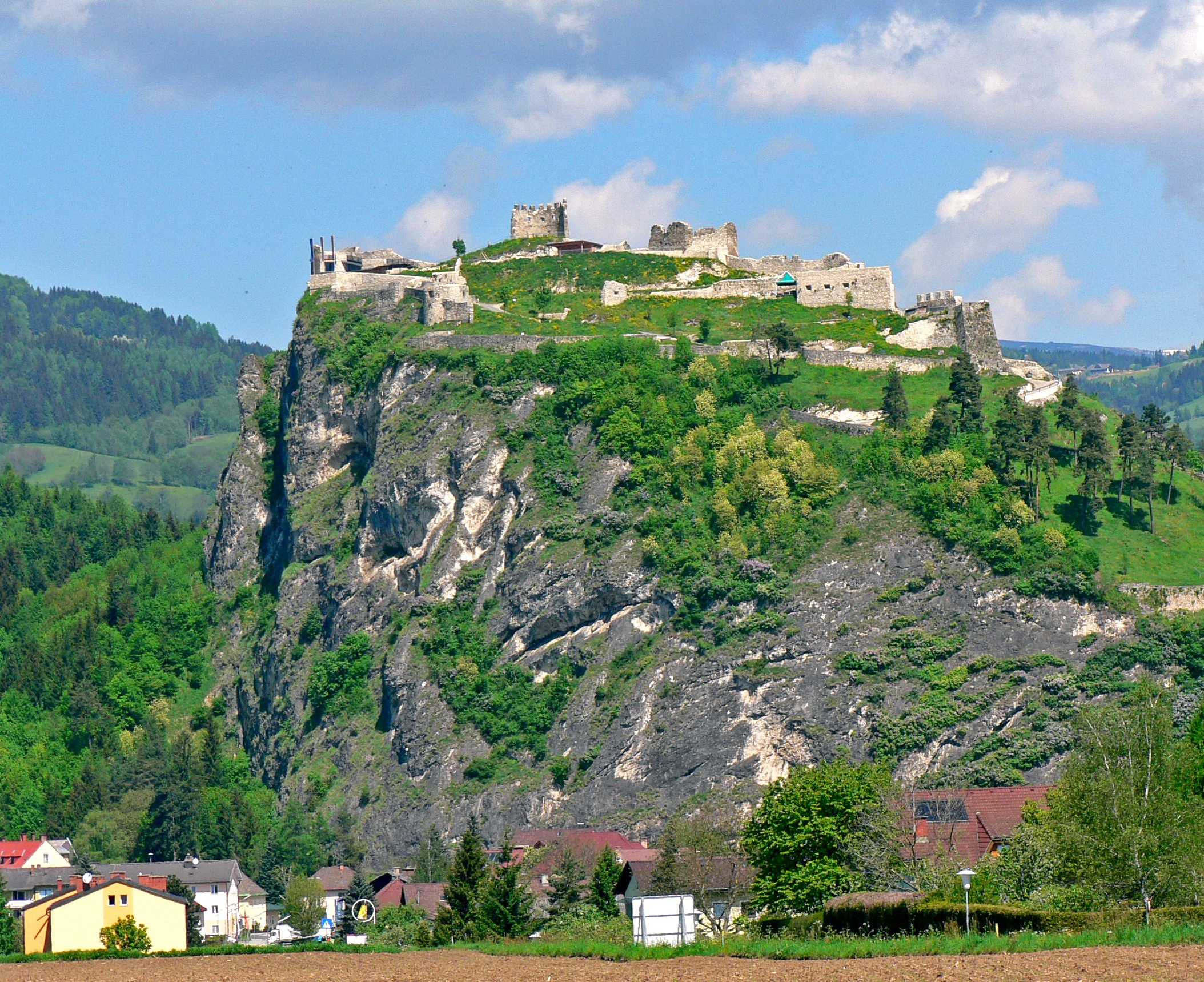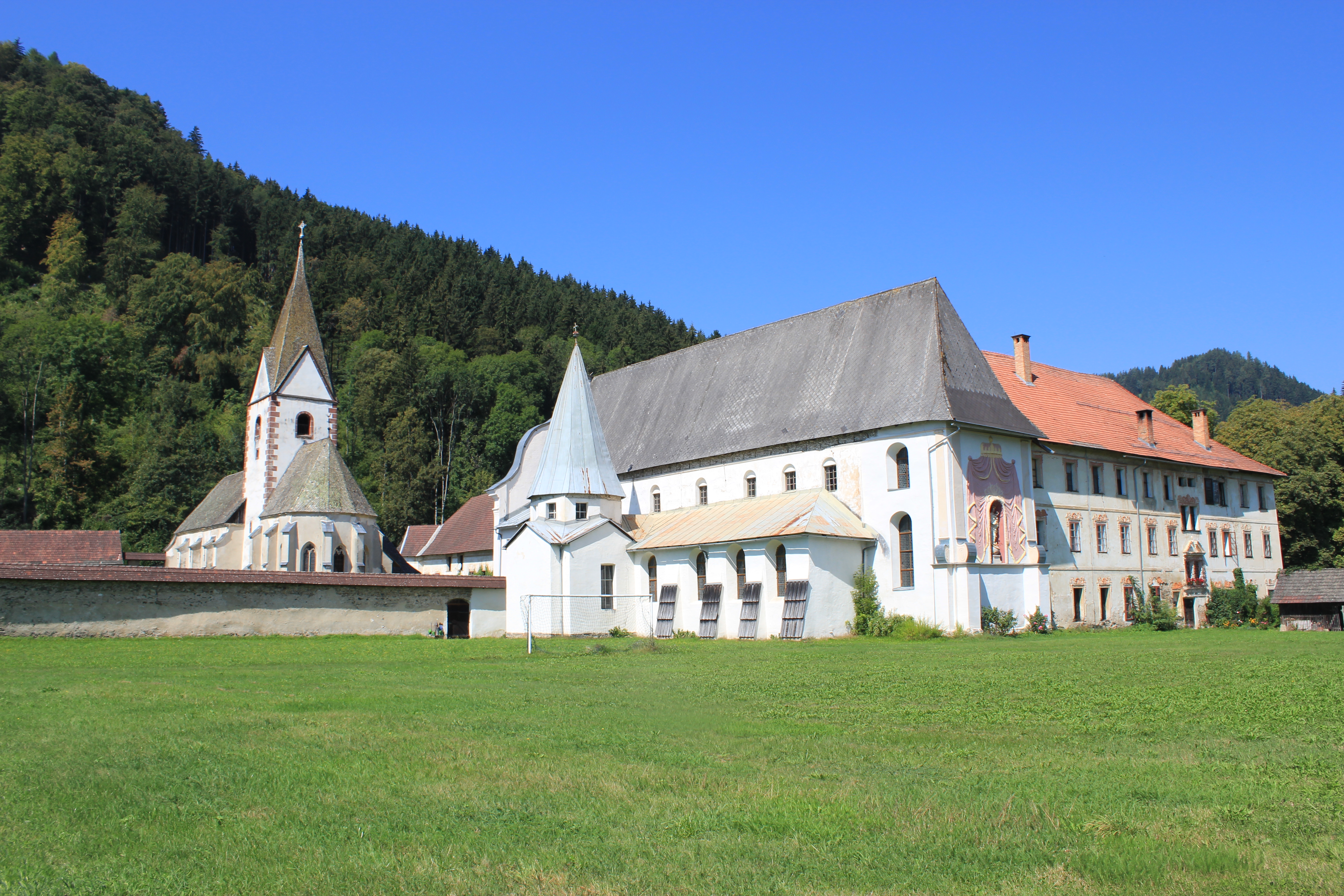Griffen, Austria on:
[Wikipedia]
[Google]
[Amazon]
Griffen ( sl, Grebinj) is a
 From the 7th century onwards, the ''Jauntal'' (Slovene: ''Podjuna'') area was a centre of the
From the 7th century onwards, the ''Jauntal'' (Slovene: ''Podjuna'') area was a centre of the  From about 1233 the Bamberg bishops had the Romanesque Griffen parish church enlarged and rebuilt as a
From about 1233 the Bamberg bishops had the Romanesque Griffen parish church enlarged and rebuilt as a
market town
A market town is a settlement most common in Europe that obtained by custom or royal charter, in the Middle Ages, a market right, which allowed it to host a regular market; this distinguished it from a village or city. In Britain, small rural ...
in the district of Völkermarkt
Völkermarkt (; sl, Velikovec) is a town of about 11,000 inhabitants in the Austrian state of Carinthia, the administrative capital of Völkermarkt District. It is located within the Drava valley east of the Carinthian capital Klagenfurt, north ...
in the Austria
Austria, , bar, Östareich officially the Republic of Austria, is a country in the southern part of Central Europe, lying in the Eastern Alps. It is a federation of nine states, one of which is the capital, Vienna, the most populous ...
n state of Carinthia
Carinthia (german: Kärnten ; sl, Koroška ) is the southernmost States of Austria, Austrian state, in the Eastern Alps, and is noted for its mountains and lakes. The main language is German language, German. Its regional dialects belong to t ...
.
Geography
Griffen lies in the wide ''Jauntal'' valley of the River, between theKlagenfurt
Klagenfurt am WörtherseeLandesgesetzblatt 2008 vom 16. Jänner 2008, Stück 1, Nr. 1: ''Gesetz vom 25. Oktober 2007, mit dem die Kärntner Landesverfassung und das Klagenfurter Stadtrecht 1998 geändert werden.'/ref> (; ; sl, Celovec), usually ...
basin in the west and the Lavant Valley in the north.
The municipal area comprises the cadastral communities
A cadastral community or cadastral municipality, is a cadastral subdivision of municipalities in the nations of Austria,Cadastral Template for Austria, web-pageCT-AT Bosnia and Herzegovina, Croatia, the Czech Republic, Serbia, Slovakia, Slovenia, ...
of Griffnerthal, Großenegg (''Tolsti Vrh''), Haberberg (''Gabrje''), Kaunz (''Homec''), Kleindörfl (''Mala vas''), Pustritz (''Pustrica''), Sankt Kollmann (''Šentkolman''), Wölfnitz (''Golovica''), and Wriesen (''Brezje''). It is further subdivided into 35 villages and hamlets.
History
 From the 7th century onwards, the ''Jauntal'' (Slovene: ''Podjuna'') area was a centre of the
From the 7th century onwards, the ''Jauntal'' (Slovene: ''Podjuna'') area was a centre of the Slavic settlement of the Eastern Alps The settlement of the Eastern Alps region by early Slavs took place during the 6th to 8th centuries.
It is part of the southward expansion of the early Slavs which would result in the characterization of the South Slavic group, and would ultimatel ...
and part of the early medieval principality of Carantania
Carantania, also known as Carentania ( sl, Karantanija, german: Karantanien, in Old Slavic '), was a Slavic principality that emerged in the second half of the 7th century, in the territory of present-day southern Austria and north-eastern ...
. Up to today it remains a core territory of the Carinthian Slovenes
Carinthian Slovenes or Carinthian Slovenians ( sl, Koroški Slovenci; german: Kärntner Slowenen) are the indigenous minority of Slovene ethnicity, living within borders of the Austrian state of Carinthia, neighboring Slovenia. Their status of t ...
.
The settlement was first mentioned in an 822 deed, after Carantania had been incorporated into the Carolingian Empire
The Carolingian Empire (800–888) was a large Frankish-dominated empire in western and central Europe during the Early Middle Ages. It was ruled by the Carolingian dynasty, which had ruled as kings of the Franks since 751 and as kings of the Lom ...
and evolved to the Bavarian March of Carinthia
The March of Carinthia was a frontier district (march) of the Carolingian Empire created in 889. Before it was a march, it had been a principality or duchy ruled by native-born Slavic (or semi-Slavic) princes at first independently and then unde ...
. From 1124 onwards Bishop Otto of Bamberg
Otto of Bamberg (1060 or 1061 – 30 June 1139) was a German missionary and papal legate who converted much of medieval Pomerania to Christianity. He was the bishop of Bamberg from 1102 until his death. He was canonized in 1189.
Early life
Th ...
had Griffen Castle erected within the Carinthian
Carinthia (german: Kärnten ; sl, Koroška ) is the southernmost Austrian state, in the Eastern Alps, and is noted for its mountains and lakes. The main language is German. Its regional dialects belong to the Southern Bavarian group. Carint ...
possessions of the prince-bishopric, received from the hands of King Henry II of Germany
Henry II (german: Heinrich II; it, Enrico II; 6 May 973 – 13 July 1024), also known as Saint Henry the Exuberant, Obl. S. B., was Holy Roman Emperor ("Romanorum Imperator") from 1014. He died without an heir in 1024, and was the last ruler o ...
in 1007. The ''Grivena'' fortress was acknowledged as a Bamberg estate by Emperor Frederick Barbarossa
Frederick Barbarossa (December 1122 – 10 June 1190), also known as Frederick I (german: link=no, Friedrich I, it, Federico I), was the Holy Roman Emperor from 1155 until his death 35 years later. He was elected King of Germany in Frankfurt on ...
in 1160. From 1237 Griffen held market rights
A market town is a settlement most common in Europe that obtained by custom or royal charter, in the Middle Ages, a market right, which allowed it to host a regular market; this distinguished it from a village or city. In Britain, small rural ...
.
Premonstratensian
The Order of Canons Regular of Prémontré (), also known as the Premonstratensians, the Norbertines and, in Britain and Ireland, as the White Canons (from the colour of their habit), is a religious order of canons regular of the Catholic Church ...
monastery. The first canons descended from Vessra Abbey
Vessra Abbey (german: Kloster Veßra) was a Premonstratensian monastery in the village also named Kloster Veßra in the district of Hildburghausen, Thuringia, Germany.
The monastery was founded in the 1130s by Gotebold II, Count of Henneberg, ...
in the Franconian County of Henneberg
The House of Henneberg was a medieval German Graf, comital family (''Grafen'') which from the 11th century onwards held large territories in the Duchy of Franconia. Their county was raised to a Princes of the Holy Roman Empire, princely county ('' ...
. The monastery complex was completed in 1272 and significantly enlarged by Baroque
The Baroque (, ; ) is a style of architecture, music, dance, painting, sculpture, poetry, and other arts that flourished in Europe from the early 17th century until the 1750s. In the territories of the Spanish and Portuguese empires including t ...
buildings in the 17th century. Griffen remained the only Premonstratensian abbey in the Inner Austria
Inner Austria (german: Innerösterreich; sl, Notranja Avstrija; it, Austria Interiore) was a term used from the late 14th to the early 17th century for the Habsburg hereditary lands south of the Semmering Pass, referring to the Imperial duchies ...
n lands until its abolition under the rule of Emperor Joseph II
Joseph II (German: Josef Benedikt Anton Michael Adam; English: ''Joseph Benedict Anthony Michael Adam''; 13 March 1741 – 20 February 1790) was Holy Roman Emperor from August 1765 and sole ruler of the Habsburg lands from November 29, 1780 unt ...
in 1786.
Griffen itself remained a possession of the Prince-Bishopric of Bamberg until the estates were purchased by Empress Maria Theresa
Maria Theresa Walburga Amalia Christina (german: Maria Theresia; 13 May 1717 – 29 November 1780) was ruler of the Habsburg dominions from 1740 until her death in 1780, and the only woman to hold the position ''suo jure'' (in her own right). ...
in 1759. The castle decayed and today lies in ruins. The present-day municipality emerged in 1850, it temporarily also comprised neighbouring Ruden. After the Carinthian referendum of 1920, multiple tensions arose between the Slovene- and German-speaking population, which culminated in the persecution and displacement of Carinthian Slovenes after the Austrian ''Anschluss
The (, or , ), also known as the (, en, Annexation of Austria), was the annexation of the Federal State of Austria into the German Reich on 13 March 1938.
The idea of an (a united Austria and Germany that would form a " Greater Germany ...
'' to Nazi Germany
Nazi Germany (lit. "National Socialist State"), ' (lit. "Nazi State") for short; also ' (lit. "National Socialist Germany") (officially known as the German Reich from 1933 until 1943, and the Greater German Reich from 1943 to 1945) was ...
in 1938.
Politics
Seats in the municipal assembly (''Gemeinderat'') as of 2009 local elections: *Austrian People's Party
The Austrian People's Party (german: Österreichische Volkspartei , ÖVP ) is a Christian-democratic and liberal-conservative political party in Austria.
Since December 2021, the party has been led provisionally by Karl Nehammer. It is currentl ...
(ÖVP): 14
* Alliance for the Future of Austria (BZÖ) and Independents: 5
*Social Democratic Party of Austria
The Social Democratic Party of Austria (german: Sozialdemokratische Partei Österreichs , SPÖ), founded and known as the Social Democratic Workers' Party of Austria (german: link=no, Sozialdemokratische Arbeiterpartei Österreichs, SDAPÖ) unti ...
(SPÖ): 4
Notable people
The village of Altenmarkt (''Stara vas'') is the birthplace of Austrian writerPeter Handke
Peter Handke (; born 6 December 1942) is an Austrian novelist, playwright, translator, poet, film director, and screenwriter. He was awarded the 2019 Nobel Prize in Literature "for an influential work that with linguistic ingenuity has explored t ...
, winner of the Nobel Prize in Literature.
References
Cities and towns in Völkermarkt District {{Carinthia-geo-stub